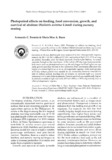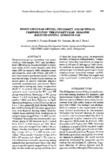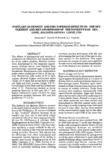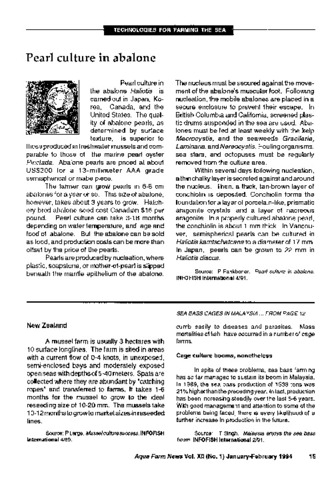Photoperiod effects on feeding, food conversion, growth, and survival of abalone (Haliotis asinina Linne) during nursery rearing
Share
Abstract
Juveniles of Haliotis asinina, 10 mm shell length were subjected to four photoperiodic regimes namely, 6L:18D, OL:24D, diffused 12:12D, and ambient light (12L:12D) serving as control. Juveniles were fed fresh seaweed, Gracilariopsis bailinae, in excess amounts throughout the experiment. At the end of a 105-day experiment, juveniles held under ambient photoperiod were significantly bigger and had higher average daily growth rate than the rest of the treatments. Feed conversion efficiency was higher at ambient light than at other photoperiodic regimes. Daily feeding rates at 65-day culture period were similar for all treatments; however towards the end of culture period, feeding rate of abalone at ambient light was lowest compared to the rest of the treatments. Percent survival was significantly higher in animals at ambient light and at 6L: 18D with 99% and 97% respectively, than at other photoperiodic regimes.
Subject
Collections
Related items
Showing items related by title, author, creator and subject.
-
Spontaneous spawning, fecundity and spawning periodicity in the donkey's ear abalone Haliotis asinina Linnaeus 1758
Fermin, Armando C.; Gapasin, Rolando S.J.; Teruel, Myrna B. (Phuket Marine Biological Center; Phuket Marine Biological Center Special Publication 21(1), 2000)Spontaneous group spawning was monitored in wild-caught (WC) and hatchery-bred (HB) abalone broodstock (Haliotis asinina) held in duplicate tanks at 1:3 (male: female) ratio from June 1997 to January 1999. Abalone ... -
Postlarvae density and photoperiod effects on the settlement and metamorphosis of the donkey's ear abalone, Haliotis asinina Linne, 1758
Fermin, Armando C.; Gapasin, Rolando S. J. (Phuket Marine Biological Center, 2000)The effects of photoperiod and density of postlarvae on settlement and metamorphosis of the native abalone, Haliotis asinina were determined in two separate experiments. Abalone larvae were hatched from spontaneously ... -
Pearl culture in abalone
Southeast Asian Fisheries Development Center, Aquaculture Department (Aquaculture Department, Southeast Asian Fisheries Development Center, 1994)The article discusses pearl culture in abalone which is commonly carried out in Japan, Korea, Canada, and the United States. Abalone pearl formation is also discussed.




